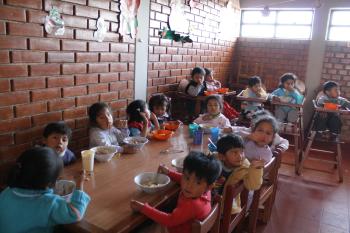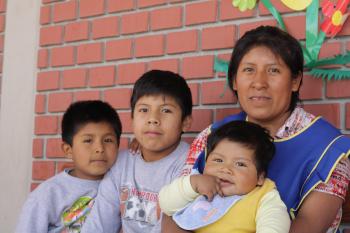Internal migrants face a reality that is far removed from the dream of a better life

Lunch at the SOS Social Centre (photo: S. Preisch)
The 1950s saw an influx of immigrants from poorer highland areas to Arequipa, making today’s population very diverse. When families migrate, support networks break down and single parents, in particular, often have no one to look after their children while they are out working. This means that children have to learn to fend for themselves at an age when they should be protected and nurtured. Another problem is that, more often than not, people do not find formal work once they have migrated. A life of illegal work, for example as street vendors, is therefore their only option. They are vulnerable to health hazards, violence and exploitation on the streets.
Families need support and guidance to break the cycle of poverty
Despite the Peruvian government’s efforts to eradicate the worst forms of child labour, it is still common to see children all over the country working in the streets, e.g. selling merchandise or shining shoes. They work in dangerous areas, late at night, and usually with their parents’ consent. It is widely regarded as normal, and even as an important lesson for later life, that children should contribute to the family’s income. Education to raise awareness of children’s rights and change fundamental attitudes is therefore urgently required. The situation is even more precarious for children who work in mines, such as the pumice stone mines in the Arequipa region. These children work in a high-risk environment that endangers both their physical and emotional wellbeing.
The only way for the next generation to break out of the cycle of poverty is for them to stay in education or training, allowing them to take up a profession as adults. Parents need to be supported so that they can allow their children every opportunity.
The only way for the next generation to break out of the cycle of poverty is for them to stay in education or training, allowing them to take up a profession as adults. Parents need to be supported so that they can allow their children every opportunity.
What we do in Arequipa

In safe hands at the day-care centre (photo: S. Preisch)
For children in Arequipa who are no longer able to live with their parents, thirteen SOS families can provide a secure and loving home to over 100 children. Together with their siblings, they are affectionately looked after by their SOS mothers.
When young people are ready to leave their SOS family in order to pursue further education or vocational training, they can join the SOS Youth Programme. Here, with the support of qualified youth counsellors, the young people can plan their future, learn to shoulder responsibility and increasingly make their own decisions.